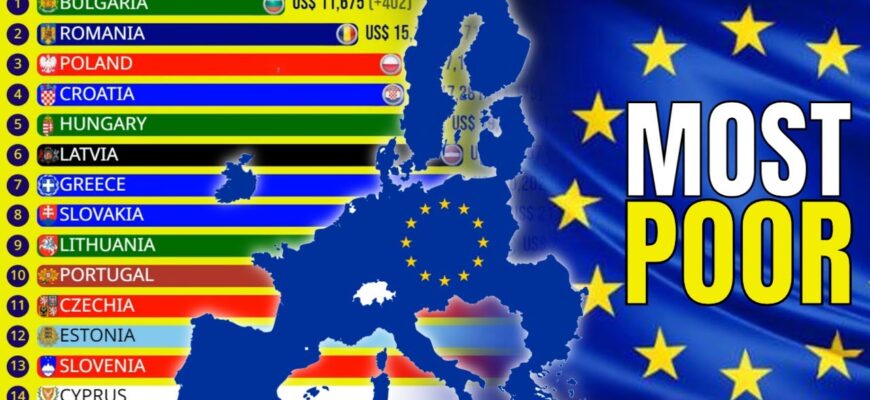By TheMors Journalists | March 10, 2025
The European Union (EU) is often seen as a powerhouse of wealth, with countries like Germany and France leading the charge. But not every member state shares the same prosperity. Some nations face serious economic challenges, leaving millions at risk of poverty. So, which are the poorest countries in the EU today? This article, prepared by journalists at TheMors, digs into the latest data to reveal the top five and explore what’s behind their struggles. Whether you’re curious about EU economics or want to understand EU poverty better, we’ve got you covered with facts and insights.
- What Makes a Country “Poor” in the EU?
- 5. Croatia: Scenic Beauty, Economic Struggles
- 4. Greece: Recovery After Crisis
- 3. Latvia: Baltic Resilience Tested
- 2. Romania: Growth Amid Inequality
- 1. Bulgaria: The EU’s Poorest Nation
- What’s Driving Poverty in These Countries?
- Can They Climb Out?
- Why This Matters to You
What Makes a Country “Poor” in the EU?
Before we dive into the list, let’s clarify what “poor” means here. We’re looking at Gross Domestic Product (GDP) per capita, adjusted for purchasing power parity (PPP), which shows how much economic output a country produces per person. It’s a solid way to compare living standards across the EU. We’ve also considered poverty rates—how many people live below the income threshold—and unemployment figures from Eurostat and the World Bank. These numbers paint a clear picture of economic hardship in 2025.
The EU has 27 member states, and while the average GDP per capita sits around €38,000 (based on Eurostat’s 2023 data, adjusted for inflation), some countries fall far below that mark. Eastern Europe, in particular, still feels the effects of post-communist transitions, while others battle unique local issues. Here’s our countdown of the top 5 poorest countries in the EU.
5. Croatia: Scenic Beauty, Economic Struggles
Starting our list at number five is Croatia, a country famous for its stunning Adriatic coast. In 2023, its GDP per capita was about €18,600 (PPP), according to Eurostat—less than half the EU average. Tourism drives much of its economy, bringing in over 20% of GDP, but that’s not enough to lift everyone out of hardship.
Why the Struggle?
Croatia joined the EU in 2013, but its transition from a Yugoslav state hasn’t been smooth. Unemployment hovers around 6.5% (2024 estimates), and rural areas lag behind urban hubs like Zagreb. Around 18% of Croatians are at risk of poverty or social exclusion, per Eurostat’s latest stats. The country’s heavy reliance on seasonal tourism leaves many workers jobless in the off-season, deepening EU poverty in these regions.
Signs of Hope
Investments in infrastructure and EU funds are helping. Projects like the Pelješac Bridge have boosted connectivity, and GDP growth is projected at 2.8% for 2025. Still, Croatia has a long road ahead to close the wealth gap.
4. Greece: Recovery After Crisis
Next up is Greece, a nation still healing from its debt crisis in the late 2000s. Its GDP per capita sits at €21,200 (PPP) in 2023, well below the EU benchmark. Once a symbol of economic collapse, Greece has made strides, but it remains one of the poorest countries in the EU.
Economic Challenges
The 2009 crisis crushed Greece’s economy, spiking unemployment to 27% at its peak. Even now, it’s around 9% (2024 data), one of the highest in the EU. Over 28% of the population faces poverty risks, with youth and rural areas hit hardest. High public debt—still over 160% of GDP—limits government spending on social programs.
Progress on the Horizon
Tourism and shipping are bouncing back, and EU recovery funds from the Next Generation EU package (€750 billion total) are fueling growth. Forecasts suggest a 2.5% GDP rise in 2025. Yet, for many Greeks, daily life remains tough.
3. Latvia: Baltic Resilience Tested
Latvia, a small Baltic state, ranks third with a GDP per capita of €22,500 (PPP) in 2023. Despite joining the EU in 2004 and adopting the euro in 2014, it struggles to keep pace with wealthier neighbors.
What’s Holding Latvia Back?
Latvia’s Soviet past left it with outdated infrastructure and a reliance on low-value industries like timber and agriculture. Unemployment is moderate at 6.2% (2024), but wages are low—averaging €1,300 monthly before taxes. About 22% of Latvians are at risk of poverty, with rural regions suffering most due to depopulation as young people move west for better jobs.
A Brighter Future?
Tech and manufacturing are growing, and Riga is becoming a startup hub. EU investments in digitalization could lift Latvia’s economy, with a projected 3% growth in 2025. Still, EU poverty remains a stubborn issue here.
2. Romania: Growth Amid Inequality
Romania takes the second spot, with a GDP per capita of €16,800 (PPP) in 2023—one of the lowest in the EU. It’s a country of contrasts: Bucharest booms with IT jobs, while rural areas languish in poverty.
Root Causes
Romania’s shift from communism to a market economy after 1989 was rocky. Corruption and weak institutions slowed progress, and 34% of its people face poverty or social exclusion—the highest rate in the EU, per Eurostat 2023. Unemployment is low at 5%, but many jobs pay poorly, especially in agriculture, which employs a fifth of the workforce.
Steps Forward
Romania’s economy is one of the EU’s fastest-growing, with a 4% GDP increase expected in 2025, driven by tech and manufacturing. EU funds are modernizing roads and schools, but the rural-urban divide keeps it among the poorest countries in the EU.
1. Bulgaria: The EU’s Poorest Nation
Topping our list is Bulgaria, the poorest country in the EU, with a GDP per capita of just €14,900 (PPP) in 2023. Despite 17 years in the EU, it lags far behind the pack.
Why So Poor?
Bulgaria’s communist legacy left it with crumbling infrastructure and a weak industrial base. Corruption scandals have scared off investors, and unemployment sits at 4.5% (2024), though underemployment is rife. Over 32% of Bulgarians are at risk of poverty, with pensioners and rural dwellers hit hardest. The average monthly wage is €850—barely enough to cover basics.
Fighting Back
Bulgaria’s IT sector is blooming, and EU funding is rebuilding roads and energy grids. Growth is steady at 3.2% for 2025, but it’s starting from a low base. For now, EU poverty defines much of life here.
What’s Driving Poverty in These Countries?
Several factors tie these poorest countries in the EU together:
- Post-Communist Hangover: Bulgaria, Romania, and Latvia still grapple with Soviet-era legacies—old factories, poor roads, and brain drain as talent flees west.
- Uneven Growth: Cities thrive while rural areas stagnate, widening inequality.
- Dependence on EU Aid: All five rely heavily on EU funds, but corruption or mismanagement sometimes slows results.
The EU’s Cohesion Policy pumps billions into these nations to narrow the gap, yet progress is uneven. In 2023, the EU spent €1.8 trillion on its long-term budget, including recovery funds, but poorer states need more than money—they need jobs and stability.
Can They Climb Out?
There’s hope. The EU’s Green Deal and digital initiatives promise jobs in renewables and tech—sectors these countries could tap into. Romania and Bulgaria, for instance, have cheap labor and growing IT hubs, while Croatia and Greece bank on tourism. Latvia’s small size makes it nimble for innovation. But without tackling corruption and rural neglect, EU poverty will linger.
Why This Matters to You
Understanding the poorest countries in the EU isn’t just about numbers—it’s about people. Millions face daily struggles with low wages, limited healthcare, and uncertain futures. For businesses, these nations offer untapped markets with low costs. For travelers, they’re affordable gems with rich cultures. And for policymakers, they’re a reminder that the EU’s work isn’t done.
At TheMors, we’ve sifted through data from Eurostat, the World Bank, and national reports to bring you this list. It’s a snapshot of 2025’s economic landscape, showing both challenges and potential. Want to dive deeper into global trends? Check out TheMors – Breaking News for more stories like this.









